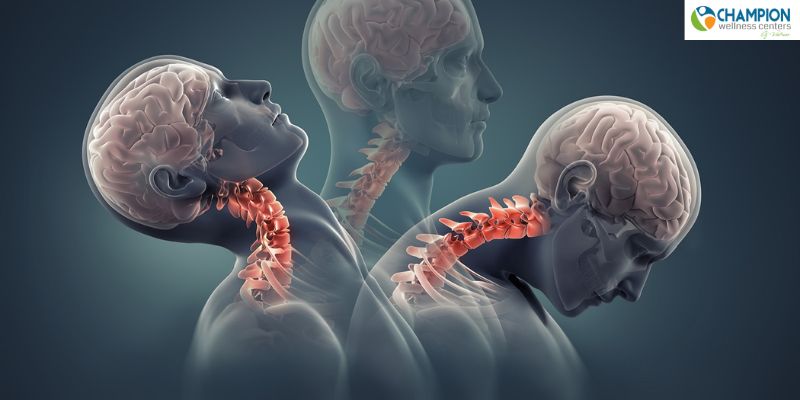Musculoskeletal pain is a common condition that affects the bones, muscles, and other tissues, causing pain and discomfort. One of the most common types of musculoskeletal pain is whiplash.
Chiropractic Treatment
Chiropractic treatment is a natural, non-invasive method for treating a variety of musculoskeletal conditions, including whiplash. It is based on the principle that the human body has the ability to heal itself when it is in proper alignment. Chiropractors use manual adjustments to realign the spine and other joints, which helps to reduce pain and improve mobility.
What Is Whiplash?
Whiplash is a common type of neck injury that occurs when the head is suddenly and rapidly jerked forward and backward. This sudden movement can cause damage to the neck muscles, ligaments, and other soft tissues. Whiplash is most commonly associated with car accidents, but it can also occur as a result of sports injuries, falls, and other physical trauma.
What Are The Causes Of Whiplash?
Whiplash can occur as a result of a variety of events, including car accidents, sports injuries, and falls. In car accidents, the sudden stop or impact can cause the head to be thrown forward and backward, leading to whiplash. Sports injuries, such as a tackle in football or a body check in hockey, can also cause whiplash. Falls can result in whiplash when the head is jerked in an unexpected direction.
What Are The Symptoms Of Whiplash?

Whiplash can cause a decrease in the range of motion in the neck, as well as tingling and numbness in the arms and legs.
The symptoms of whiplash can vary in intensity and duration, but some common symptoms include:
1. Neck pain: Whiplash can cause pain and stiffness in the neck, which may be more severe when moving the head.
2. Headaches: Whiplash can also cause headaches, which may be felt at the base of the skull or on the sides of the head.
3. Dizziness: Dizziness and lightheadedness can also occur as a result of whiplash.
4. Fatigue: Whiplash can cause fatigue and a decrease in energy levels, making it difficult to carry out everyday activities.
5. Difficulty concentrating: The brain may have a difficult time processing information, which can cause difficulty concentrating and memory problems.
6. Decreased range of motion: Whiplash can cause a decrease in the range of motion in the neck, making it difficult to turn the head or look over the shoulder.
7. Tingling and numbness: Whiplash can cause tingling and numbness in the arms and legs, which may be accompanied by weakness.
If you are experiencing symptoms of whiplash, it is important to seek medical attention as soon as possible. A healthcare provider can diagnose your condition and help you develop a treatment plan to reduce pain and improve mobility.
How Can A Chiropractor Help Treat Whiplash?
Chiropractors use a variety of techniques to help treat whiplash. The first step in the treatment process is a thorough examination of the patient. This may include a physical examination, X-rays, and other diagnostic tests. Based on the results of the examination, the chiropractor will develop a treatment plan that is tailored to the individual’s specific needs.
Techniques Chiropractors Use To Treat Whiplash

Chiropractors use manual adjustments to realign the spine and other joints. They may also use massage, ice, heat therapy and other techniques to reduce pain and improve mobility. In addition, chiropractors may provide the patient with exercises to do at home to help speed up the healing process.
Here are some of the techniques better explained…
1. Manual adjustments: The chiropractor will use gentle, controlled force to realign the spine and other joints. This can help reduce pain and improve mobility.
2. Massage: Massage can help relieve muscle tension and reduce pain. The chiropractor may use deep tissue massage or other techniques to help reduce swelling and improve blood flow.
3. Ice therapy: Applying ice to the affected area can help reduce inflammation and relieve pain.
4. Heat therapy: Heat therapy can help improve circulation and promote healing. The chiropractor may use a heat pack or hot towel to help soothe the affected area.
5. Stretching and exercise: Stretching and exercise can help improve the range of motion and reduce pain. The chiropractor may provide the patient with specific exercises to do at home.
6. Electrical stimulation: The chiropractor may use electrical stimulation to help relieve pain and reduce muscle spasms.
7. Ultrasound: Ultrasound therapy can help reduce inflammation and improve circulation.
The techniques used to treat whiplash will vary depending on the individual’s specific needs and the severity of their symptoms. The chiropractor will work with the patient to develop a treatment plan that is tailored to their specific needs.
Summary:
Whiplash is a common type of musculoskeletal pain that can cause a variety of symptoms. Cfhiropractic treatment is a natural, non-invasive method for treating whiplash and other musculoskeletal conditions. If you are experiencing symptoms of whiplash, it is important to seek treatment as soon as possible. With the help of a chiropractor, you can be free from pain and discomfort.



